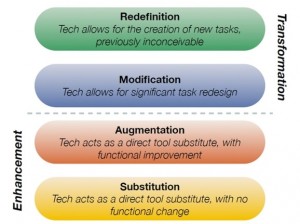 Don’t be sucked in by the ‘must have’ new product or app. Use this simple question to decide what is worth adopting, says Andy Williams, Senior Education Lead SSAT…
Don’t be sucked in by the ‘must have’ new product or app. Use this simple question to decide what is worth adopting, says Andy Williams, Senior Education Lead SSAT…
Ok, let’s start with an admission, I can be an annoying person to work with. In my teaching, the annoyance seems to stem from my fondness for asking the question, ‘so what’? But use of this question can help us distinguish the new and useful from products and services that are just gimmicky.
So try it. When thinking about new technologies to teach with, and for your learners to learn with, ask yourself the question. There is a new tablet that we could give every child in the school? So what? That new app looks amazing! So what? I am going to book the computer room for my next lesson. So what?
That new app looks amazing! So what?
If the answer does not include ‘it will have a positive impact on teaching and learning… ’ then you may need to rethink.
This is not to say that I am against digital technologies – far from it. I‘m writing this on my laptop, listening to the audio from a recording on my smartphone, and my tablet is showing the relevant research on the internet.
What we all need to focus on is where we can use these technologies effectively. There is little doubt that our learners live in a rich digital world and they need high levels of digital literacy. But are we transforming their learning through the effective use of technologies? Sometimes yes and sometimes no.
This is one of the reasons why I use the SAMR model to help make decisions on implementation.
SAMR is not a hierarchy: it is not ranking substitution as a lower level and redefinition higher. But what it does give us is an answer to ‘so what?’ We can start to see how we are using the technologies and where they can transform the learning experience.
Technology does not have to be ‘state of the art’ to be transformational. The pedagogy does. Consider the impact of sites such as Khan Academy: inspirational videos that have transformed learning for vast numbers of students.
Sal Khan himself admits the videos are fairly basic: it is the content he is interested in and passionate about. The technology delivers that excitement for the subject to the learner.
Is the technology appropriate?
Starting with the learning, consider whether technology is appropriate and if so, how it adds to the learning. For teachers looking for support in applying digital technologies to the classroom, look to sites such as Diigo for Education, where teachers nationally and internationally bookmark, annotate and share a plethora of education websites, for all to apply to their classrooms.
Or why not check Edshelf which describes itself as a discovery engine of apps, programs and electronic products for teaching and learning. Best of all these are reviewed by teachers.
Find out more about the SAMR model.
Find out more about Diigo for Education.
Follow Andy on Twitter: @Faber_2013
Follow SSAT on Twitter: @SSAT

